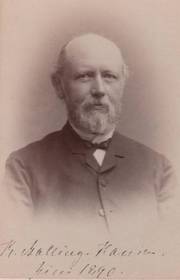American Scientist Replicating Rasmus Malling-Hansen’s Research.
By Jørgen Malling Christensen.
Illustrations and additional comments: Sverre Avnskog.
This article presents a summary of important research into the seasonal variation of the growth of American schoolchildren, carried out in the 1920s by the well-known scientist, Carroll Edwards Palmer(1903-1972). Dr Palmer was a towering figure in Public Health, particularly with regard to research on the diagnosis, treatment and prevention of tuberculosis. He initially served as a consultant at the U.S. Public Health Service, and from 1942 as director of the Tuberculosis Research Program. In 1949 he was appointed director of the World Health Organization Tuberculosis Research Office.[1]
In November 2016, through the diligent research of Sverre Avnskog, one of Dr Palmer’s key reports was identified and found: “Seasonal Variation of Average Growth in Weight of Elementary School Children”, published in the March 3, 1933 Vol. 48, No. 9, issue of “Public Health Reports”.[2]
Previously, our website has documented how the Swedish MD, cardiologist and scientist Dr Karl Gustav Vilhelm Nylin (1892-1961)replicated Malling-Hansen’s research in his 1920s study of Swedish schoolchildren and their seasonal growth and reached similar results and conclusions as Malling-Hansen(see under the section “Periods in the growth of children”: “A Swedish Scientist in Malling-Hansen’s Footsteps; Gustav Nylin’s doctoral thesis: Periodical Variations in Growth, Standard Metabolism and Oxygen Capacity of the Blood in Children, Stockholm 1929.)
Dr Palmer’s report covers 22 pages and includes many very detailed technical tables. Instead of transcribing the report in extenso, I have chosen to present report excerpts of some of the highlights, together with my comments.
My comments will be in italics, while report text will be in bold vertical print.
PUBLIC HEALTH REPORTS
VOL. 48 MARCH 3, 1933 NO.9
SEASONAL VARIATION OF AVERAGE GROWTH IN WEIGHT OF ELEMENTARY SCHOOL CHILDREN
By CARROLL E. PALMER, M.D., Consultant in Child Hygiene, United States Public Health Services
In 1921, the United States Public Health Service, assisting in a health demonstration project at Hagerstown[3], Md. began an investigation of certain general problems connected with the physical growth of elementary school children. The results of various parts of the growth study will be published in a series of papers, of which this, the first of the series, will be limited to a consideration of the variations of growth in weight occurring coincident with changes of season.
(- - -)
The basic material for the study consists of monthly weighings of approximately 2,500 native-born white children whose ages ranged from 6 to 16 years. This group represents the children enrolled in the eight elementary schools of the city. Weighings of the children were begun late in September and were repeated at approximately monthly intervals until late in May for each of the school years from (September) 1923 until (May) 1928.
(- - -)
Since 1920 a great many papers have appeared which deal with seasonal and short-time cyclic manifestations of physical growth processes. It is of interest that the classical work of Malling-Hansen[4] has been reviewed no less than eight times during the past 12 years. The recent, excellent, monograph by Nylin[5] contains a comprehensive and unbiased review of the literature and a bibliography of 259 relevant titles. It will be considered sufficient in this report to refer to Nylin’s paper, to state very briefly his conclusions, and to note the work which has appeared since his publication.
JMC: It is noteworthy that Palmer refers to Malling-Hansen’s research as “classical”, and that it has been “reviewed more than eight times during the past 12 years”. In other words: Malling-Hansen was one of the main founders and pioneers of this area of research, and his studies were the point of departure – if you will: the standard – against which Palmer and the other scientists of the 1920s and 1930s compared themselves.
The consensus of informed opinion upon the question of seasonal variation of growth in weight affirms that growth proceeds at maximal rates during the late summer and autumn, continues at considerably reduced rates during the winter, and falls to minimum rates in the spring and early summer. This typical fluctuation has been observed in Danish children in Copenhagen, in Swedish children in Stockholm, in Scotch children in Aberdeen, in German children in Berlin, and in American children in Boston and New York.
JMC: This paragraph is also of the utmost importance! “The consensus of informed opinion” is, of course, scientific parlance for “those who are highly educated agree that...”
And according to Palmer the scientists in this particular research niche at the time were in agreement that Malling-Hansen’s results were correct, and they had been tested and found to be repeated in other locations and some forty years later in Stockholm, in Berlin, in Boston and in New York.
It is of interest to note, also, that growth in weight is accelerated in the fall (April, May, and June) and greatly reduced in the spring (October, November and December) in children of English stock in Melbourne. This latter observation, which was reported by Fitt[6] in an infrequently quoted but important paper, furnishes evidence that the cyclic manifestation of physiologic activity is associated in some as yet unexplained manner with seasonal changes.
Working over the earlier data of Woodbury, by rigorous statistical methods Berkson[7] has adduced definitive evidence for a typical seasonal change of growth rates. Later, Orr and Clark[8] showed that the most rapid growth of weight occurs (in the Northern Hemisphere)during September, October, and November, and that the smallest increments are added during the spring and summer.
One of the great merits of the Palmer report is that it points us in the direction of other similar research efforts, and here we learn that even in the southern hemisphere – in the Asutralian and New Zealand setting – such research has been carried out and reached the same conclusions!
(- - -)
It will be seen that at every age for both boys and girls the growth rates are at a maximum for the periods centering about October 6. The rates for November show a sharp reduction for every class. About December 1, growth is reduced from one-third to one-half of the November value, and the January, February, and March rates generally follow, with some fluctuations, horizontal or slightly downwards trends. The April gains show a reduction to approximately one-half of the winter values, and the May increments drop to a very low minimum. The average rates for the summer show a definite rise, in most cases closely approaching those of March 1. The summer rates are not precisely comparable with the preceding monthly rates, and very probably represent continued slow growth during June and, likely, July, followed by a fairly sharp rise during August and September. The seasonal trend is similar for all age groups, the older children showing, perhaps, slightly more marked relative changes, but the essential character of the curve is typical for every age and for both sexes.
JMC: The last sentence of the preceding paragraph is of crucial importance: “the essential character of the curve is typical for every age and for both sexes”! Malling-Hansen would have been very happy and proud if he had lived to see how his research niche were to continue, two generations after his era, and confirm his own results when applying the same methods to much larger samples of school children!
( - - -)
However, Palmer is fair enough to acknowledge that not all of his contemporaries were in agreement about the existence of a seasonal growth pattern:
In a recent paper, Emerson[9] has attacked the interpretation of seasonal variations in growth as reported by Malling-Hansen, Schmidt-Monnard, Porter, Bleyer, and others. That writer conceives that the seasonal cycle is not a “general biologic law”. It is implied that lack of “hygienic living conditions”, “acute infections”, “fatigue”, etc., are examples of nonbiologic phenomena. Emerson’s report concludes with the statement:
Growth of children living under favorable conditions can be found who, in the absence of infection or other sicknesses, exhibit a regular monthly gain in weight regardless of the season of the year.
JMC: Palmer then discusses to what extent the difference between healthy children and children with more than average sickness would influence their respective growth patterns. He summarises his conclusions as follows:
...It is impossible to show a statistically significant difference between the sick group and the not-sick group. The absolute irregularity of the difference between the two groups accompanied by the systematic regularity with which the seasonal trends coincide presents, however, very strong evidence that the typical seasonal variation is not the result of including in the data records of seriously ill children who fail to gain or who lose weight. (- - -) It is evident that that no clear relationship exists between the general incidence of sickness and seasonal growth in average weight.
The latter findings are, of course, in no way contradictory to the common knowledge that sickness can and does prevent normal growth. In no way, either, do they fail to substantiate the meticulous work of Malling-Hansen, which shows that the seasonal trend can be affected by sickness. The evidence is, however, reasonably conclusive that the observed seasonal variation of growth in weight can not be explained as the result of either individual or group illness.
SUMMARY AND CONCLUSIONS
Under the supervision of the medical officers of the United States Public Health Service, approximately 2,500 native-born white children attending the elementary schools of Hagerstown, Md., were weighed monthly during the school years from September, 1923, to May, 1928.
The basic data, specific for sex and single years of age, but unspecified with respect to the year of measurement, were analyzed by the calculation of the ordinary statistical constants of the following frequency distributions:
(1) Actual weight on the October weighing day.
(2) Weight increment for the separate months of the school year from September to May.
(3) Weight increments for the summer vacation period, an interval of approximately three and one-half months.
The results of the analysis may be summarized under sex headings:
(1) Maximum rates of average growth in weight are observed during the fall months, intermediate rates during the winter, and minimum rates during the spring. The average rate of growth during the summer period is approximately equal to the rates observed during February and March. The same cyclic changes are observed in both sexes and for each yearly age group from the sixth through the fourteenth year. These findings are in agreement, with few exceptions, with the previous work on the subject.
(2) During the sixth and seventh years, there is no consistent difference between the growth rates of boys and girls. During the eighth and ninth years, boys apparently grow at slightly greater rates than the girls. In the spring of the tenth year, the rates for girls become greater than the rates for boys and remain higher for each subdivision of the year until the fall of the fourteenth year, when the rates for the boys become greater and remain so through the fifteenth year.
(3) Analysis of the changes with age of growth rates for individual months shows:
(a) Maximum growth rates for girls in the eleventh and twelfth years.
(b) Maximum growth rates for boys in the fourteenth and fifteenth years.
(c) No evidence which may be interpreted as representing a “pre-adolescent slump” or “lag” of average growth in weight.
(4) Suggestive evidence is brought out of a seasonal sex difference in the appearance of the “adolescent acceleration” of average weight growth. The “adolescent acceleration” in girls is apparently more pronounced in the spring and summer, and in boys is more pronounced in the fall and early winter.
(5) Comparison of the monthly growth rates of a selected group of children who were not absent from school during an entire year with the remainder of the group who were absent one or more days because of sickness shows that the typical seasonal variation in growth is not the result of including in the data records of seriously ill children who fail to gain or who lose weight.
(6) Comparison of the seasonal curve of monthly growth rates with the seasonal curves of incidence of sickness indicates that there is no concomitant variation between the two.
JMC: The last two pages of the report consists of the references, and this list is of great relevance and importance to us in our continued research, since the scientific reports and researchers listed therein are closely related to Malling-Hansen’s research. So, by making use of Palmer’s list of references we have a shortcut to tracking down the other scientists in that era – the 1920s and the beginning of the 1930s – who were involved in testing and trying to replicate, or disprove, Malling-Hansen’s results.
One of those references is that of a Danish physician and scientist, Søren Hansen, listed as follows as reference no 9:
Hansen, S.: (1912) On the increase of stature in certain European populations. Problems in Eugenics. papers communicated to the First International Eugenics Congress held at the University of London, 1912, vol.1, pp. 23-27. Published by the Eugenics Education Society of London.
Søren Hansen was influential in being the lead researcher of the Danish Anthropological Committee, established at the beginning of the 20th century. The focus was on physical anthropology and on heredity, and the overall purpose of the committee’s work was to study the Danish population in regard to physical and physiological characteristics: height, weight, eye colour, hair colour, etc, as well as the extent to which diseases and physical defects were hereditary – e.g. deafness. The committee published its findings during the period 1907 to 1932 in three volumes entitled “Meddelelser om Danmarks Antropologi”.
Through letters by Engelke Wiberg and her correspondence with S. Hansen we know for certain that the Anthropological Committee requested Malling-Hansen’s research documents, which were kept by Johanne Agerskov and/or by Engelke Wiberg at the time, and that the two sisters allowed the committee some of those documents, and handed them over in 6 packages in September 1911 (further details are provided, in Danish, in our chapter about the Anthropological Committee. Considering the timing of this handover in relation to S. Hansen’s paper, presented at the congress in London in 1912, it is very likely that Hansen used some of Malling-Hansen’s findings for his own analysis and the paper presented by him. However, we are yet to find his congress presentation!
SA: The story of how Søren Hansen got hold of the papers that Malling-Hansen left after him, is quite fascinating. All the data from the weighings and measurings were noted in colured notebooks, and after Malling-Hansen's sudden death in 1890, all the papers were placed in wooden boxes that were closed with nails and kept in the attic of the Royal Institution in Copenhagen. Søren Hansen first turned to RMH's brother-in-law, Frederik Heiberg, who was the headmaster of the Institute at that time, and through him, Hansen got in contact with the husband of RMH's daughter Zarah, Fritz Bech, and he promised to try and make the papers available to Mr. Hansen. Bech turned to the sisters to get their permission, and as the sisters were convinced to have spiritual contact with their late father, they "asked" him if they could give the papers to Søren Hansen. The spirit of Malling-Hansen asked them to go to the attic, open the boxes, and then he chose which notebooks he would allow them to give to Mr. Hansen and which notebooks he wanted them to destroy. One of the daughter's husband, Michael Agerskov, gives the details about this events in his book, "Nogle Psykiske Oplevelser" from 1925. The papers that were destroyed were the very latest data from RMH's investigations, and a draft for a new book. All the other notebooks were given to Søren Hansen. There has been some confusion about what happened to the notebooks later on. But we know that they were returned to the daughters, and my personal opinion is that they were kept at the Royal Institution for many years. When The International RMH Society visited the museum at the school in 2008, Jan William Rasmussen in The Society of Deaf History told me that they had about 200 such notebooks in the Museum in the basement of the school. They have later on been given to the National Archive of Denmark together with all the papers from the Royal Institution.
Reverting now to Palmer’s references, this is the total list of references – in addition to those mentioned in the above footnotes and text – that we need to follow up, checking to what extent and in what way the various researchers have further elaborated on Malling-Hansen’s groundbreaking research in the 1870s and 1880s:
1. Martin, R.: (1924) Die Körperentwicklung Münchener Volksschulkinder in den Jahren 1921, 1922, und 1923. Anthropologischer Anzeiger, Stuttgard, Jahrgang 1, Heft 2, pp.76-95.
2. Mumford, A.A.: (1912-1914) The physique of the modern boy. Transactions of the Manchester Statistical Society, pp. 127-168.
3. Paterson, Ada G., and Marsden, E.: (1927) Physical growth and mental attainment: New Zealand school children. Extract from report of the Department of Health, New Zealand. P.10. Published by W.A.G. Skinner, Government Printer, Wellington, N.Z.
4. Jackson, C.M.: (1931) Changes in stature, weight, and body build of female students at the University of Minnesota during a period of 18 years. The Anatomical Record, vol. 49, pp. 71-80.
5. Wolff, G.: (1932) Die Nachwirkung der Kriegshungerperiode auf das Schulkinderwachstum. Johann Ambrosius Barth, Leipzig.
6. Boas, F.: (1898) The Growth of Toronto children. Report of the Commissioner of Education, 1896-97, vol. 2, pp. 1541-1599. Government Printing Office, Washington, D.C.
7. Schiøtz, C.: (1923) Physical development of children and young people during the ages of 7 to 18-20 years. An investigation of 28,700 pupils at public (elementary) and higher (secondary) schools in Christiania. Videnskabsselskabets Skrifter. I. Mat.-Naturv. Klasse., No.4. Published by Jacob Dybwad, Christiania.
8. Gray, F.: (1910) Diurnal variations in weight. American physical Education Review, vol. 15, pp. 6-14.
9. Mumford, A.A.: (1927) Healthy Growth. Oxford Medical Publications. Oxford University Press.
10. Schwartz,Louis, Britten, R.H., and Thompson, L.R.: (1928) Studies on physcial development and posture. Pub. Health Bul. No. 179. United States Government Printing Office, Washington, D.C.
11. Davenport, C.B., and Minogue, Blanche M.: (1930) Physical growth in the second decade. Physical and Mental Adolescent Growth, pp. 5-20. The proceedings of the Conference on Adolescence, Cleveland, Ohio, October 17 and 18, 1930. Published by the Brush Foundation and Western Reserve University.
12. Todd, T.W.: (1930) The adolescent lag. Physical and Mental Adolescent Growth, pp. 1-5. The proceedings of the Conference on Adolescence, Cleveland, Ohio, October 17 and 18, 1930. Published by the Brush Foundation and Western Reserve University.
13. Davenport, C.B.: (1926) Human growth curve. Journ. of General Physiology, vol. 10, pp. 205-216.
14. Frankel, L.K., and Dublin, L.I.: (1916) Heights and weights of New York City children, 14 to 16 years of age. Metropolitan Life Insurance Co., New York.
15. Porter, W.T.: (1893) The physical basis of precocity and dullness. Academy of Science of St.Louis. Transactions 1893, vol. 6, pp. 161-81.
16. Boas, F., and Wissler, C.: (1906) Statistics of growth. Report of the Commissioner of Education for the year ending June 30, 1904. Vol. 1, pp.25-132. Government Printing Office, Washington, D.C.
17. Richey,H.G.: (1931) Blood pressure in boys and girls before and after puberty; its relation to growth and maturity. Am. Jour. Dis. of Children, vol. 42, pp. 1281-1330.
18. Boas, F.: (1932) Studies in growth. Human Biology, vol. 4, pp. 307-350.
19. Collins, S.D.: (1931) The health of the school child – a study of sickness, physical defects and mortality. Pub. Health Bul. No. 200. United States Government Printing Office, Washington, D.C.
[1] JMC: Source: www.jhsph.edu/about/history/heroes-of-public-health/
[2] JMC: PHRs is the official journal of the U.S. Public Health Service and the Surgeon General and has been published ever since 1878. It is bi-monthly, and all major articles are peer-reviewed, ensuring a high standard of quality and relevance. The journal publishes original research and commentaries in the areas of Public Health practice and methodology, original research, public health law, and public health schools and teaching. Another wonderful aspect of this journal is that it is freely available to the public electronically! We can access and download all issues! See: phr.sagepub.com
[3] JMC: Hagerstown is a city in Washington County, Maryland, founded in 1762 by Jonathan Hager, a German immigrant from Pennsylvania. In 1920 the city had 28,064 inhabitants (Source: Wikipedia)
[4] CEP: Malling-Hansen, R.: (1883) Fragment I. Über Periodizität im Gewicht der Kinder an täglichen Wägungen wahrgenommen. (1886) Fragment II und III. Perioden im Gewicht der Kinder und in der Sonnenwärme. Kopenhagen.
[5] CEP: Nylin, G.: (1929) Periodical variations in growth, standard metabolism and oxygen capacity of the blood in children. Acta Medica Scandinavica. Supplementum 31. Stockholm.
[6] CEP: Fitt, A.B.: (1924) The human energy-rhythm through the year. From the Report of the Sixteenth Meeting of the Australasian Association for the Advancement of Science, vol. 16, pp.704-742. Published by W.A.G. Skinner, Government Printer, Wellington, N.Z.
[7] CEP: Berkson, J.: (1930) Evidence of a seasonal cycle in human growth. Human Biology, Vol. II, pp. 523-538.
[8] CEP: Orr, J.B., and Clark, M.L. (1930) A report on seasonal variation in the growth of school children. The Lancet. Vol. II, No 5581, pp. 365-367. JMC: Our website has this report already, see the article from the Lancet august 1930.
[9] CEP: Emerson, H.: (1927) Seasonal variation in growth of school children. Journ.Am.Med.Assoc., vol.89, pp.1326-1330.

- The original report.




